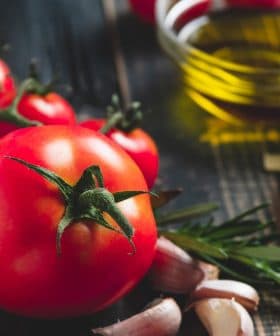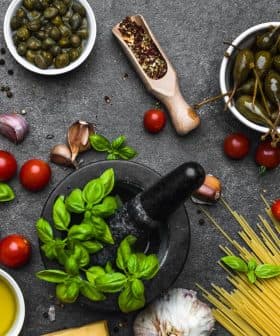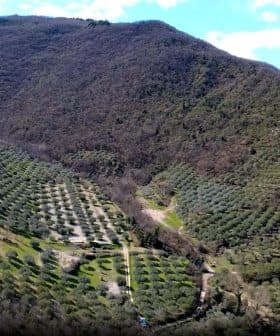Newly-Proposed Med Index Rating Seeks to Surpass Nutri-Score and Nutrinform
Italian researchers have developed the Med Index, a new labeling system that combines nutritional and environmental information into a single logo on food packaging, focusing on extra virgin olive oil and items from the Mediterranean diet. The Med Index aims to help consumers make quick, informed choices about their food while also encouraging producers to improve the quality and sustainability of their products, contrasting with existing systems like Nutri-Score and Nutrinform Battery. The Med Index uses a pyramid to indicate portion size, energy balance, and sustainability, but does not cover processed foods or those with specific additives.
A team of Italian researchers has devised a new labeling system to include a single front-of-pack logo comprising the food item’s nutritional qualities and environmental impacts.
The authors of the new Med Index said that it was created to allow consumers to choose their food at a glance while also pushing producers to enhance the quality and sustainability of their products.
It seems a good solution to introduce in a moment in which the olive oil sector is giving so much in terms of trying to educate the consumers about its qualities.
The focus of the labeling system is extra virgin olive oil and the food items traditionally associated with the Mediterranean diet.
The researchers at the University of Bari, in Puglia, said how current labeling platforms such as Nutri-Score or the Italian alternative Nutrinform Battery do not consider the environmental impact of food production. They also questioned the criteria used by both systems to qualify food as healthy or unhealthy.
See Also:Hundreds of Scientists Support Adoption of Nutri-Score Labeling System“The multi-disciplinary research team that developed Med Index has highlighted several Nutri-Score shortcomings,” Maria Lisa Clodoveo, an associate professor at the University of Bari’s interdisciplinary school of medicine, told Olive Oil Times.
“Nutri-Score rates food for a well-balanced diet on the basis of 100-gram or 100-milliliter samples. Still, we all know that not all food is consumed in the same quantities,” she added. “Therefore, a paradox is generated for many different products, whose role in a healthy diet cannot be judged on the basis of 100 grams. For example, nobody would eat 100 milliliters of extra virgin olive oil or 100 grams of Parmigiano Reggiano.”
Clodoveo said that a lot had changed since Nutri-Score’s first introduction in France.
“In the last years, we have experienced a significant acceleration in knowledge,” she said. “We do not talk of calories anymore but talk about nutrigenomics and nutrigenetics.”
The new Med Index places extra virgin olive oil among the most relevant ingredients in a healthy diet. By comparison, Nutri-Score rates extra virgin olive oil with a “Yellow C” on a scale from “Green A” to “Red E.”
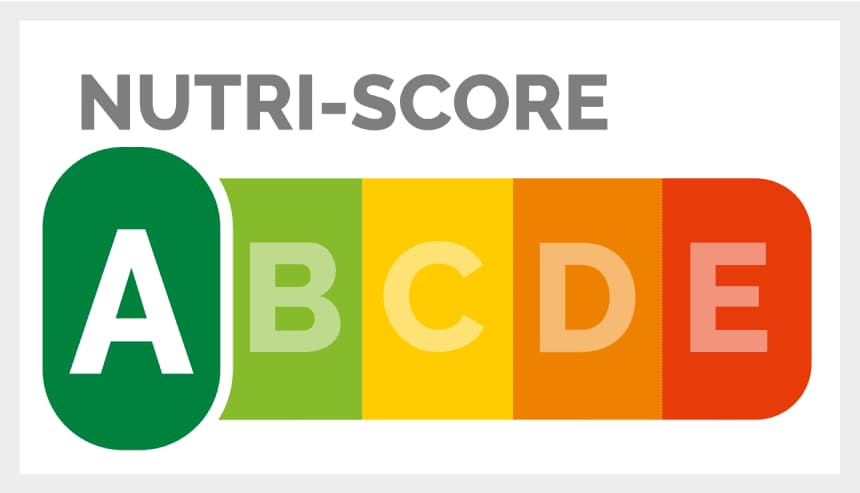
“That same rating is given to olive oil, seeds oil and many other fats that do not share in any way the healthy and unique profile of extra virgin olive and its polyphenols, through which it plays a pivotal nutrigenomic role,” Clodoveo said.
“Nutri-Score is therefore not scientifically up to date and does not take the latest research into due account,” she added.
To the Italian scientists, the C‑rating for extra virgin olive oil “is a synonym for mediocrity,” Clodoveo said. “Nutri-Score can not tell vegetable fat that have polyphenols and those that do not.”
However, Serge Hercberg, the developer of Nutri-Score, told Olive Oil Times in a July 2020 interview that the point of Nutri-Score is to compare items in the same food group and not among food groups.
“[The C for olive oil is] the best score possible for added fats and even for vegetable oils,” he said. “The public health recommendations do not suggest consuming olive oil without limits, but they encourage consumers to favor it over other vegetable oils and especially over animal fats.”
The Italian standard, which has been created as an alternative to Nutri-Score, Nutrinform Battery, also does not convince the Med Index researchers.
It is a food labeling platform that has gone through a swift development process that involved relevant academic institutions. Still, Clodoveo said, “it did not involve the Italian scientific world as a whole.”
“[Nutrinform Battery] uses an iconographic representation, the battery, at the opposite of what common sense tells us,” she added. “When we think of a battery, we can associate it being fully charged with full health, as many food supplements do in their graphics. Nutrinform Battery goes the opposite way.”

Nutrinform Battery
The Med Index does not only talk about nutrition.
“Medical researchers, food chemistry scientists, economists, physicians, psychologists and nutritionists were asked to cooperate in developing Med Index,” Clodoveo said. “The result is a colored rating scale which only deploys ‘good,’ ‘better’ and ‘best’ ratings while focusing specifically on extra virgin olive oil and the other Mediterranean diet specialties.”
The labeling system devised in Bari uses a pyramid to show how many portions are included in the labeled pack, how much physical activity is required to compensate for the energy provided by the food item and how well it scores in terms of nutritional, environmental and social sustainability.
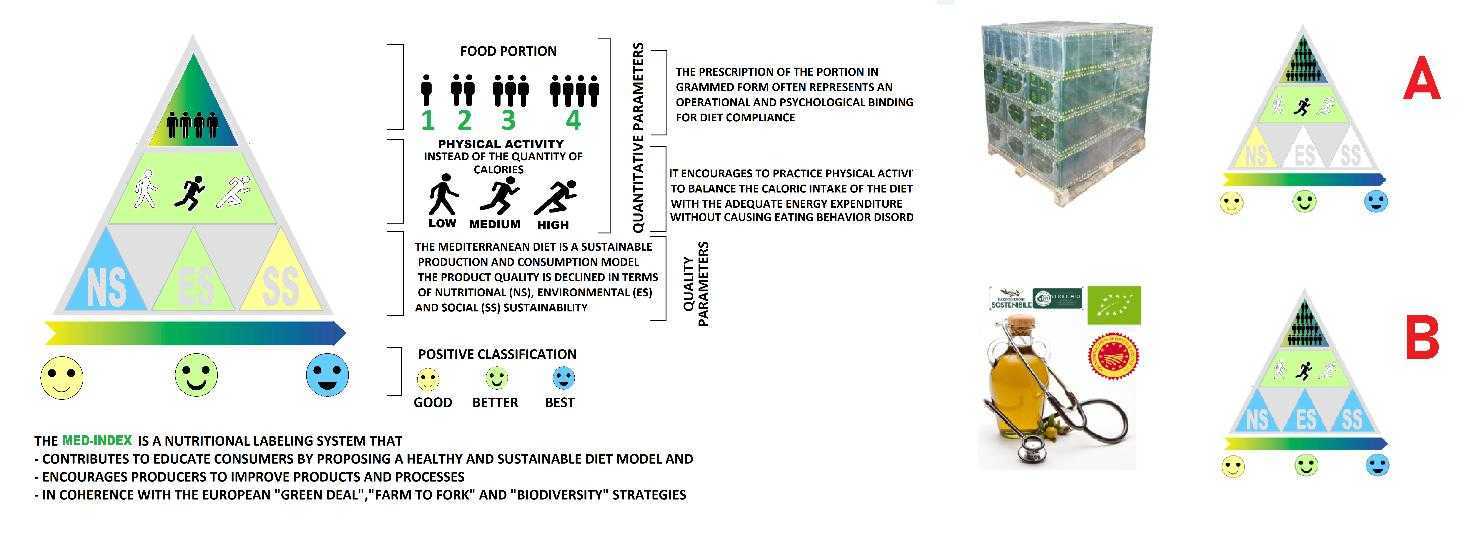
Photo: Med Index
However, there are some limitations to the new labeling system. The Med Index does not include processed and ultra-processed food as well as those with specific additives or adjuvants.
“It is inspired by the MedDiet principles, such as consuming different kinds of seasonal food and food subjected to low or no processing,” Clodoveo said. “We have established a series of complex criteria that allow the consumer to make a conscious choice in a matter of seconds.”
Among these criteria are how the income generated by purchasing the food is spread throughout the production chain and the level of gender equality in the supply chain.
The prospect of labeling extra virgin olive oil within the Med Index rating system has been welcomed by producers in Italy.
“It seems a good solution to introduce in a moment in which the olive oil sector is giving so much in terms of trying to educate the consumers about its qualities,” Elia Pellegrino, president of the Italian Olive Milling Association, told Olive Oil Times.
“Until now, consumers did not show a profound interest in extra virgin olive oil labeling. They are making most of their choices on the basis of the price of the product instead,” she added. “Our hopes are for a simple label, which the consumers can easily understand.”
According to Pellegrino, the most relevant issue for producers “is that the label certifies the unique qualities of extra virgin olive oil.”
Med Index proponents explained that due to the Covid-19 pandemic and the acceleration of nutrition knowledge and environmental and biodiversity protection, the European Union should not rush to have its labeling standard in place.
“We hope that the 2022 deadline for choosing the labeling platform will be delayed,” Clodoveo said. “It is a step of the Farm-to-Fork strategy; the decision Brussels will take will affect Europe for at least the next 10 years.”
According to the researchers, the fact that a proposed label such as Nutri-Score was adopted only by a few countries and fiercely opposed by others shows that the current debate is not inclusive enough.
“The idea to exclude some kinds of food from Nutri-Score, such as those protected by the European designations of origin, further shows that this proposal falls short of its goals,” Clodoveo said.
“We need the scientific community to debate for consumers to understand what labeling means, for policymakers to evaluate what science has brought to the table,” she concluded. “It is a big decision that will have an impact on agri-food production and marketing.”





